In February of 1968 Francis Quirk organized an exhibit of the works of Mario Cooper and Sidney Gross. This post will focus on Mario Cooper perhaps the most influential artist/illustrator we have seen without a Wikipedia page. Ironically, Cooper does have a Wikipedia page in German.
 |
| Mario Cooper Self-Portrait National Academy of Design |
Mario Cooper was born in Mexico City in 1905. His father was a Californian, his mother a native of Mexico. When Mario was nine, the Coopers moved to California where the boy received his education. He studied art at the Otis Art Institute, the Chouinard School, and at Columbia University under sculptor Oronzio Maldarelli.
There are three aspects to this man's career: illustrator, educator and serious artist.
Illustrator
Mario is known as an illustrator. He plunged into the professional world via engraving house, art service, and advertising agencies. He became an expert letterer and layout man. He studied drawing in night classes wherever possible and copied the work of Dean Cornwell, Harvey Dunn and Pruett Carter. His professional break occurred in 1930 when Collier's magazine, a leading general interest publication, first accepted his work. Watson mentions that Cooper's preferred media were colored inks and watercolor. However, we have discovered at least one oil painting.
He would go on to illustrate many pieces including books by Agatha Christie.
Mario Cooper 1944
 |
| Mario Cooper 1947 |
 |
| Mario Cooper 1941 |
 |
| Mario Cooper 1944 |
 |
| Mario Cooper 1956 |
For completion we are including an oil painting by Mario Cooper below. We were unable to find any examples of his sculpture.
 |
| Oil Painting "Portrait of a Red-Headed Woman" by Mario Clark |
Educator
Cooper clearly enjoyed sharing the art of working with watercolors. He belonged to several organizations including the Society of Illustrators, the Allied Artists of America, the National Academy of Design, the American Watercolor Society, and the Audubon Society.
He was president of the American Watercolor Society (AWS) from 1959 to 1986.
He published four watercolor painting books, Painting with Watercolor, Flower Painting in Water Color (1962), The Art of Drapery: Styles and Techniques for Artists (1984) and Watercolor by Design (1980) that can still be found in online bookstores and some libraries.
Cooper taught at the Pratt Institute and Columbia University. The internet is littered with former students who are now artists who benefited from his demanding attention. These include Polly Wood, Linda Crawford, Lou Marek, Zoe Mac, Pat Percy and a host of others.
Serious Artist
Please do not take the title of this section as being pejorative to illustration art. Illustration art can be extremely good and is frequently better than academic or serious art. I can wax eloquent on the merits of the works of Rockwell, Homer and many others.
In his later years, Cooper used watercolors to paint landscape and other studies, such as those exhibited at Lehigh in 1968. In his review write-up in the Brown and White, Mike Jeppson described the displayed works as multitudes, monuments and wall effects. The wall effects were close ups of objects such as a lock on a gate. Lehigh would purchase "The Rock Laguna Beach" which was part of the exhibition. The other two classes of paintings are designed to be viewed from afar and may have included paintings like San Travaso below.
 |
| San Travaso by Mario Cooper |
 |
| Venice by Mario Cooper |
 |
| London by Mario Cooper |
He also participate in the US Air Force's History of Aviation Program. In 1953 Cooper would paint for the US Air Force receiving the courtesy rank of Brigadier General and a plane with seven men to travel the world painting. His work from this period is largely in the Pentagon or national collections. Later in his career Cooper would develop a relationship with NASA and serve as one of the onsite artists painting the space program.
 |
| "The Glittering Hours" 1969 watercolor of Apollo 11 by Mario Cooper |
Cooper's painting "Battle Dress" is now in the collection of the National Air and Space Museum along with works by Norman Rockwell, Andrew Wyeth and Peter Hurd.
The Quirk-Cooper Relationship
We don't know the details of the relationship between Francis Quirk and Mario Cooper, but we suspect that there paths may have crossed due to several similarities. Both had worked as illustrators selling commercial works. Both had won Tiffany Fellowships. Both worked in East Coast academia. But the artist depicted in the 1944 Cooper painting below seems to have a striking similarity to Francis Quirk as drawn in the pastel self-portrait at the bottom of the page.
Mario Cooper work from 1944 seems to capture Francis Quirk
 |
| Francis J. Quirk Self-portrait in pastel Undated |














